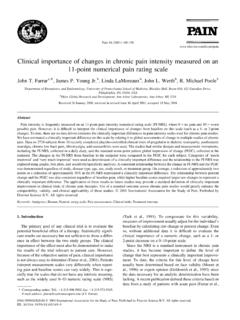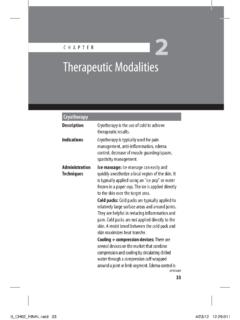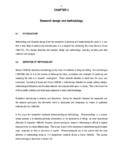Transcription of Efficacy of Neural Mobilization in Treatment of …
1 Journal of American Science, 2011;7(4) 566 Efficacy of Neural Mobilization in Treatment of Low Back Dysfunctions Sahar M. Adel Department of Basic Science, Faculty of Physical Therapy, Cairo University, Cairo, Egypt. Abstract: The study was conducted to investigate the effect of lumbar Mobilization techniques and Neural Mobilization technique on sciatic pain, functional disabilities, centralization of symptoms in patients, latency of Hoffmann reflex, and of degree of nerve root compromise in chronic low back dysfunction (LBD).
2 Pre-test post-test group design has been used. Sixty patients with chronic (LBD) from both sexes were involved, aged between 30 60 years. They were divided into two equal groups, Group (A) received lumbar spine Mobilization and exercise intervention and Group (B) received Straight leg raising stretching (SLR) in addition to lumbar Mobilization and exercise. Self-report measures included a body diagram to assess the distribution of symptoms, numeric pain rating scale (NPRS), modified Oswestry Disability Index (ODI), Patients recorded the location of their symptoms on the body diagram to determine the extent to which centralization occurred after Treatment , The results of study revealed that: there was a significant difference between both groups on pain (p = ), functional disabilities improvement ( ), location of symptoms (p = ) and sciatic nerve root compression (p = ).
3 However there is no significant Differences in H-reflex latency (p = ) between group A and group B (post test). It is concluded that straight leg raising (SLR) stretching may be beneficial in the management of patients with LBD. SLR stretching in addition to lumbar spine Mobilization and exercise was beneficial in improving pain, reducing short-term disability and promoting centralization of symptoms in this group of patients. [Sahar M. Adel Efficacy of Neural Mobilization in Treatment of Low Back Dysfunctions. Journal of American ). -N: 1545]. (ISS573-566 Science 2011;7(4): Key words: Chronic low back dysfunction, Straight leg raising (SLR) stretching, lumbar Mobilization , H-reflex latency.
4 Introduction Lumbar-spine disorders rank fifth among disease categories in the cost of hospital care and account for higher costs resulting in absent from work and disability than any other category (1). Disability associated with low back dysfunction (LBD) continues to rise, contributing to a substantial economic burden that exceeds nearly 50 billion annually in the United States alone. Health care expenditures among individuals with LBD are also 60% greater than those without LBD with 37% of the costs a direct increase of physical therapy services (2).
5 Physical therapists utilize a wide range of interventions in the management of LBD; however, evidence for the effectiveness of these interventions is limited (3). Intervention in patients with a disease requires that the intervention has to be more beneficial, safer, and cost-effective compared with the untreated natural history. Intervention should occur after accurate diagnosis and consideration of prognostic findings. This dilemma is particularly important in patients with low back dysfunction (LBD) with or without radiculopathy (4).
6 The SLR test is frequently used in the assessment of patients presenting with lumbar spine dysfunction and is one of the few indicators that has been shown to identify the degree of impairment from LBD'' Furthermore, it has been suggested that improving the range of SLR has a beneficial effect in restoring normal movement and reducing the degree of impairment due to low back dysfunction (5). Unfortunately, there is no research evidence to support these conjectures. The movement of SLR induces posterior pelvic rotation and thereby flexion of the lumbar spine as well as flexion of the hip.
7 The study was conducted to investigate the effect of lumbar Mobilization techniques and Neural Mobilization technique (SLR stretch) and on sciatic pain, functional disabilities, centralization of symptoms in patients, latency of Hoffmann reflex, and of degree of nerve root compromise in chronic LBP with lumbar radiculopathy (sciatica). Subjects Sixty patients with chronic (LBD) from both sexes were involved, aged between 30 60 years. They were divided into two equal groups, Group (A) received lumbar spine Mobilization and exercise intervention and Group (B) received Straight leg raising stretching (SLR) in addition to lumbar Mobilization and exercise.
8 Patients were required to have symptoms that referred distal to the buttocks, reproduction of the patient s symptoms with straight leg raise testing, no change in symptoms with lumbar flexion or extension, and a baseline Oswestry score greater than 10%. Patients with red flags for a Journal of American Science, 2011;7(4) 567serious spinal condition ( infection, tumors, osteoporosis, spinal fracture, etc.) were excluded. Also patients who were pregnant, has a history of spinal surgery, positive neurologic signs or symptoms suggestive of nerve root involvement (diminished upper or lower extremity reflexes, sensation to sharp and dull, or strength), osteoporosis, or exhibited a straight leg raise (SLR) test of less than 45 were also excluded.
9 Design of the study: The design of study was pre-test post-test group design with dependant variables were pain level, functional disabilities, amplitude of Hoffmann reflex, and degree of nerve root decompression, The independent variables were neurodynamic techniques, and lumbar Mobilization . Instrumentation 1- Magnetic resonance imaging (MRI): Magnetic resonance imaging (MRI) was used to measure degree of nerve root compression by disc herniation using grading system. The system was used in grading compromise of the intraspinal extradural lumbar nerve root consists of four grade categories.
10 Grade 0 (normal): No compromise of the nerve root is seen. There is no evident contact of disk material with the nerve root, and the epidural fat layer between the nerve root and the disk material is preserved. Grade 1 (contact): There is visible contact of disk material with the nerve root, and the normal epidural fat layer between the two is not evident. The nerve root has a normal position, and there is no dorsal deviation. Grade 2(deviation): The nerve root is displaced dorsally by disk material. Grade 3(compression): The nerve root is compressed between disk material and the wall of the spinal canal; it may appear flattened or be indistinguishable from disk material (6).






